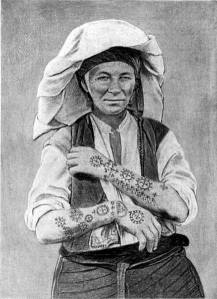Traditional Tattoos: Impressive Intangible Heritage of Croats in Bosnia and Herzegovina

Tattooed wife from Lašvanske Valley, Bosnia. Photo Credit: Traditional Croatian Tattoos
My interest in this topic started as a quite personal thing. As a tribute to my grandmother who passed away two years ago. I remember that I was impressed that my grandmother had a tattoo, and more over, that she gotten it when she was a young girl, about 9 years old. The story goes like this…
The Greek historian Strabo (1st century BC) mentions tattooing as a custom of inhabitants of the area corresponding to present day Bosnia and Herzegovina. He said, “they are poor, and they have tattoos as other Illyrian tribes.”
However, this phenomenon became widespread among the Roman Catholic population of Bosnia and Herzegovina during the Ottoman rule of their lands (1463 – 1878), and lasted up until 20th century, more precisely until 1938. With the creation of communist Yugoslavia, which part Bosnia and Herzegovina became after World War II, this practice of tattooing was not as desirable and it faced a sharp decline. The last recorded example of a person who had the traditional tattoo done with a traditional method is from the 1984.
Bosnian Catholics would tattoo their children hoping that it would save them from Ottoman’s practice of taking young boys and sending them to Istanbul to become soldiers and convert them to Islam. This was done so even if that happened, their children would have a permanent reminder of who they were and where they came from. The practice was even more common among young girls. Their parents hoped that tattoos of a cross or other Christian symbols would prevent Turkish men from taking them as their wives.

Rose Zadrić, born in 1937 in Rama village Dobroš, Sicana. Photo Credit: Traditional Croatian Tattoos
Bosnian Catholic Croats used to tattoo their hands, chest, wrists or even forehead with the Christian symbols (like small cross), but also many other motifs are present. There were special days during the year when tattooing would take place (usually the time before Easter). They used natural materials to prepare a mixture, such as honey, carbon, and mother’s milk.
Even today in Bosnia and Herzegovina you can find a lot of women who have these tattoos, but they were all born around the 1930s and they are the last living generation to wear this impressive evidence of the fight that their ancestors undertook to protect their faith and origins. However, some great work on this subject has been done, like the book from the prominent archaeologist and historian Ćiro Truhelka, who did research on this subject in late 19th century. There were also some workshops for tattoo artists and also a work of young researcher Tea Turalija, who is trying to document as much as possible cases of women who are still alive, to record their stories and to take photos of their tattoos. You can follow her work on
https://www.facebook.com/pages/Traditional-CroatiaTattoo/222413247770680?ref=profile
In the end, the goal for us who see this tradition as something unique and beautiful, is to bring it to the UNESCO list of Intangible Heritage. Hope you will find it fascinating as I do.

Close-up of Rose Zadrić’s tattoos from 1947, when she was 10 years old. Photo Credit: Traditional Croatian Tattoos

Photo Credit: Traditional Croatian Tattoos

Marija Kamber finished the MA in Heritage Management in 2013 and also has a Masters in Tourism Management. With 5 years experience in marketing, she tries to combine the knowledge of those Masters into her projects. Marija plans to start work on a PhD in September in the area of cultural heritage and human rights. Her interests involve painful heritage, dark tourism, the role of heritage in conflicts and multiethnic societies, as well as the connection between heritage and human rights.
